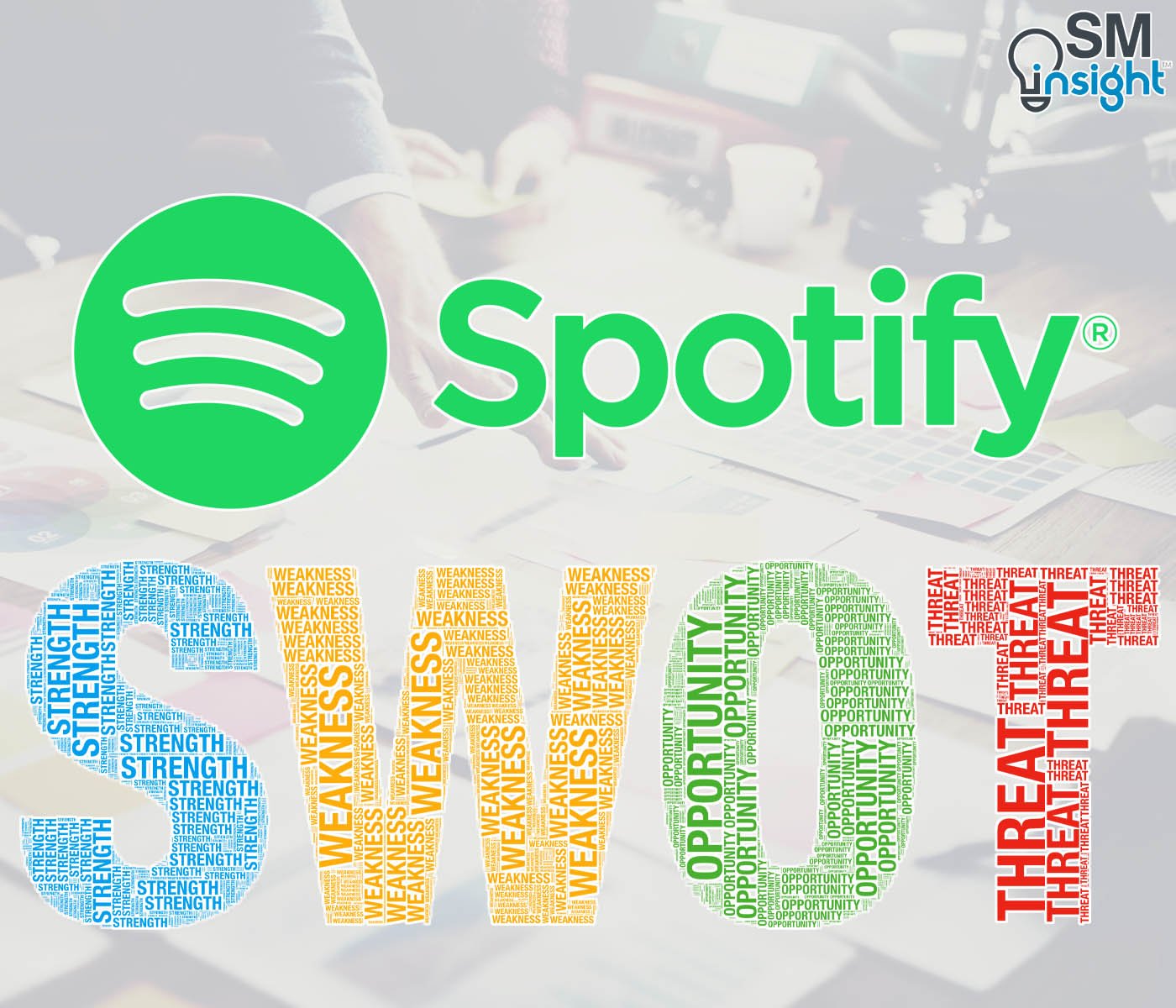This SWOT analysis of Spotify examines the external and internal environment the company operates in. The report assesses the strengths, weaknesses, opportunities and threats of Spotify and how the company has used its inner strengths and external opportunities to grow in a volatile business environment.
Company Overview
| Official Name | Spotify Technology S.A. |
| Logo |  |
| Foundation Date | April 23, 2006 |
| Founder | Daniel Ek and Martin Lorentzon |
| Industry | Music streaming platform |
| Headquarters | Stockholm, Sweden |
| Website | open.spotify.com |
| CEO | Daniel Ek |
| Number of Employees | 7,691 (2024) |
| Latest FY Revenue (2022) | $16.959 billion (2024) |
| Net Income | $1.241 billion (2024) |
| Competitors | Apple (Apple Music), Google (Youtube Music), Amazon (Amazon Music), Block (Tidal), Pandora, Deezer |
Spotify Technology S.A. is a global audio streaming platform founded by Daniel Ek and Martin Lorentzon on April 23, 2006. The company’s overall mission is to “unlock the potential of human creativity by giving a million creative artists the opportunity to live off their art and billions of fans the opportunity to enjoy and be inspired by it.”
To achieve this, Spotify offers software that can be used to stream audio content. Initially, it only offered access to music, but as the company grew over the past two decades, it expanded its content to include podcasts and audiobooks.
In this analysis, we will discuss how the company transformed the music industry and how it maintains its market leadership.
Spotify SWOT Analysis
| Strengths | Weaknesses |
|---|---|
| 1. Music industry disruptor 2. Expansive music library catering to every type of user 3. Extensive application of technology portfolio 4. Highly effective localized pricing strategy 5. Effective distribution channels 6. Established partnerships with a wide range of artists and label distributors 7. Enabled by its portfolio of acquisitions | 1. Limited revenue streams 2. Lack of competitive differentiation 3. Long history of unprofitability 4. Royalty fees that are lower than competitors’ |
| Opportunities | Threats |
|---|---|
| 1. Focusing on emerging markets 2. Expanding business segments 3. Publishing original and/or exclusive content 4. Venturing into new content verticals | 1. Highly competitive music streaming market 2. Emerging alternatives, particularly in the Web3 space 3. Consumers’ ever-shifting media consumption behavior 4. Vulnerability to persistent piracy 5. Changes in the regulatory environment |
Strengths
1. Music industry disruptor
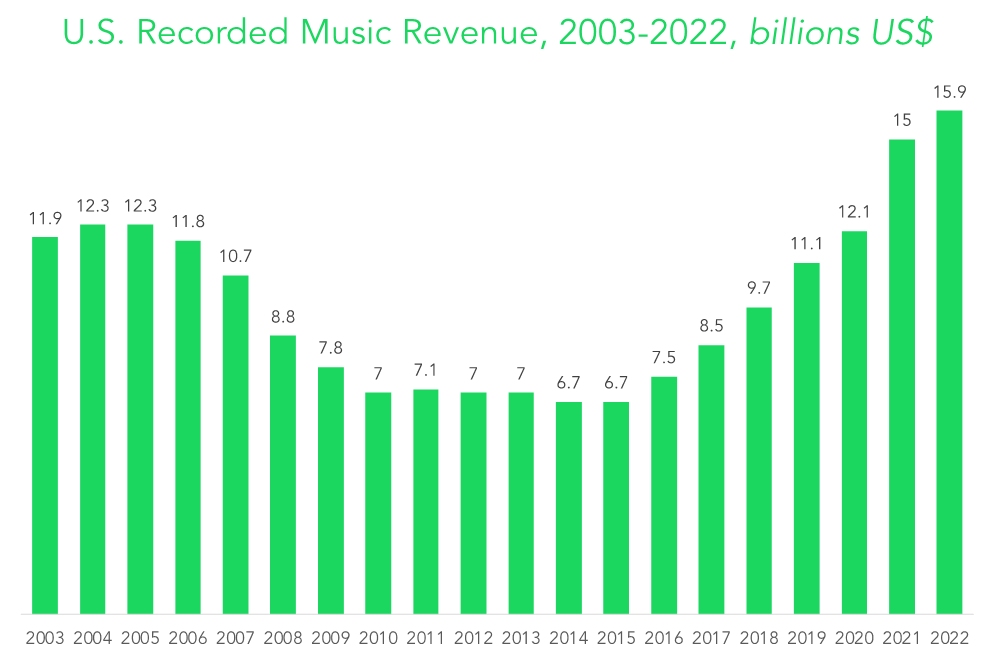
In the early 2000s, the music industry was going through a transformation in which physical sales of records were steadily declining in favor of digital files, more commonly called MP3s, driven primarily by Apple’s launch of the iPod and the subsequent release of iTunes a couple of years later.[1]
However, these files could easily be duplicated and replicated which led to rampant piracy in the industry. It was further exacerbated by the rise of peer-to-peer sharing platforms like Napster, as well as Gnutella-powered Limewire and Morpheus where users can easily download music files straight directly to local devices.[2] This caused the record-music industry to crash, particularly in the U.S., where revenues fell sharply from an all-time high of $14.6B in 1999 to $6.7B in 2015.[3]
In an effort to curb the industry’s piracy problems, Spotify emerged, offering an innovative business model of on-demand, cloud-based audio streaming service. It raised the cost of reproducing and distributing illegal copies of songs by making legally published content easily accessible through an online platform.
While the innovative business model also inadvertently led to the continued demise of physical copies of music content, it ultimately revived the music industry, which in the U.S. has now reached an all-time high in revenue at $15.9B as of 2022.[4]
Through the introduction of the on-demand streaming service, Spotify democratized access to music. Aside from eliminating the need for customers to buy and collect albums they like, the company also enabled them to be more adventurous in exploring new content. Just by paying a fixed monthly fee, they now have access to a continuously expanding library of songs.
The platform even became more inclusive when Spotify introduced a freemium model, in which people who do not want or are not capable to pay for subscription can access the ad-supported version of the platform. Since then, the company has continued to lead the transformation of the music industry, introducing new features and functionalities to its platform, along with the expansion of its offerings.
2. Expansive music library catering to every type of user
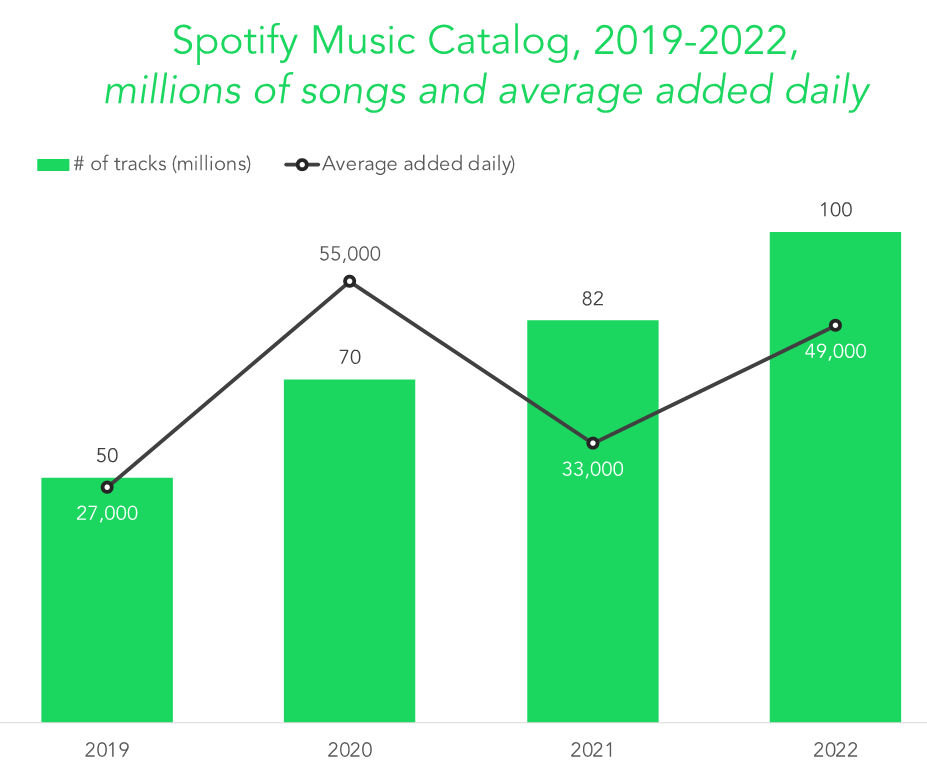
Spotify has a vast music library that has grown significantly in recent years. As of 2022, its platform boasts more than 100 million tracks available worldwide, which is 22% more than the previous year and almost double the size of its library in 2019.
The company’s library continues to expand rapidly, with reports indicating that it adds between 49,000 and 100,000 new songs every day.[5] In addition to that, the company also has a growing catalog of podcasts, introduced in 2015, with over five million episodes now available on the platform.[6]
Despite its impressive size, it is not just the sheer quantity of content that sets Spotify apart. The platform’s highly curated approach to content ensures that users can discover new artists, genres, and songs that they might not have come across otherwise.
It not only enriches the listening experience for users but also has a positive impact on artists, especially smaller ones. It improves their discoverability, which could mean higher income and a bigger fanbase for them.
3. Extensive application of technology portfolio
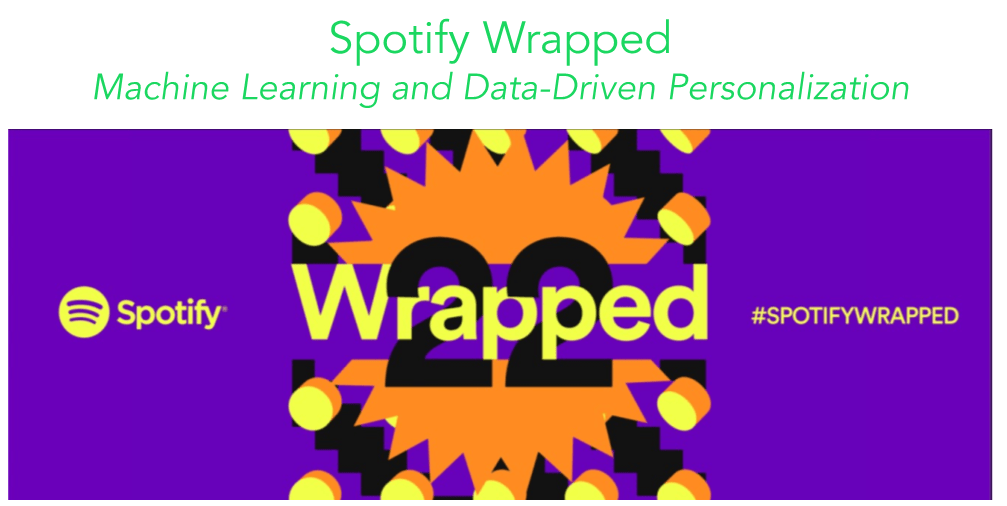
Since its inception, Spotify has been investing heavily in research and development. In the early 2000s, the company leveraged the increasing adoption of cloud computing, the expansion of network connectivity, and the growing penetration of smartphones to launch its revolutionary streaming platform.
As the platform grew, Spotify continued to innovate, utilizing data analytics tools and machine learning to generate insights from the customer data from the platform. The company uses these insights to develop new offers, enhance existing ones, and more commonly, come up with personalized recommendations for customers.[7]
Spotify also shares this anonymized data with artists and music rights holders through their Artists portal.[8] It enables them to gain a better understanding of their audience’s needs and preferences, which they can use as input for their next content and to deepen fan relationships.[9]
The company took it a step further in February 2023 when it launched the DJ.[10] It is a new AI-enabled feature that simulates the function of a radio DJ, serving as a personalized AI guide that will select music based on the user’s preferences and feedback, and provide commentary about the tracks and artists.
4. Highly effective localized pricing strategy
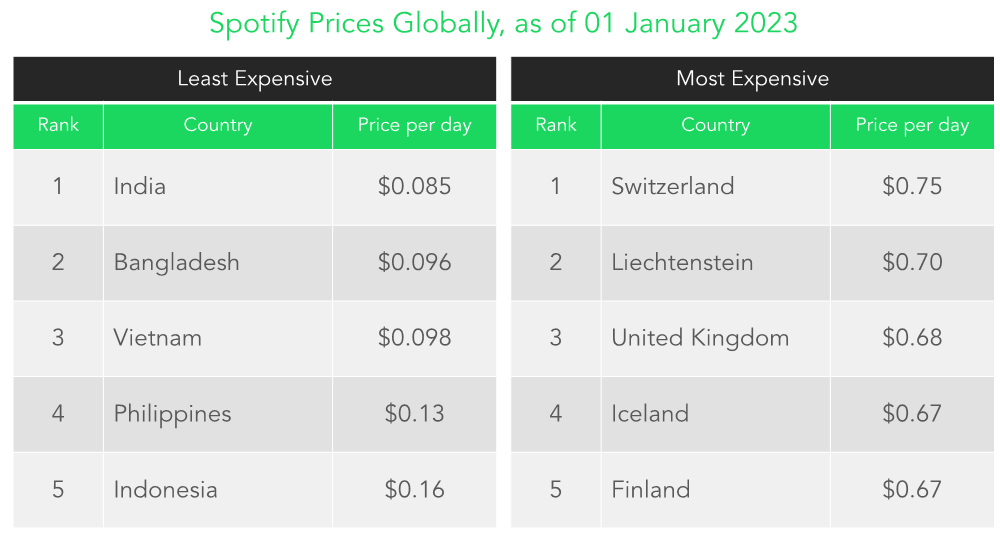
Spotify employs a localized pricing strategy in which fees across different subscription tiers vary per country. As of end-2022, the lowest prices for a monthly individual premium subscription can be found in emerging markets at just below $2, while the highest prices are above $20, found in Europe.[11]
While customers paying higher prices in certain regions may be dissatisfied, it allows Spotify to consider the economic conditions in the markets where it operates, making the platform more accessible to users who would otherwise be unable to afford the regular rates. It also helps the company to compete with both global and local music streaming platforms in each market.
In the long run, the increase in the number of premium subscribers driven by localized pricing can more than offset any potential loss in revenue from lower prices.
5. Effective distribution channels
To ensure the continued growth of its user base, Spotify has implemented an ingenious distribution strategy. As organic user growth declines, it turns to partnerships to expand its reach and make the platform available across different services and devices. They even made partnership opportunities more streamlined as they launched the self-service portal Spotify for Partners.
Spotify establishes partnerships with telecommunications providers so that the service can be bundled with mobile subscriptions. This gives subscribers access to discounted premium plan rates, free trials for a period of time, and in some cases, the ability to stream music without consuming their data allocation. Some of their well-known telco partners include AT&T, Vodafone, Orange, and Spark.
In addition, Spotify also collaborates with device manufacturers to have the app version preloaded onto various devices, including mobile phones, televisions, tablets, and wearables. Partners include Samsung, HMD Global (Nokia), and tink. With these partnerships, Spotify makes it more convenient for users to access their platform, helping them expand their reach and build brand awareness.
6. Established partnerships with a wide range of artists and label distributors
Spotify also establishes and maintains close ties with a wide range of artists and publishing rights owners. According to Loud and Clear, Spotify’s transparency website, the number of artists who have published any music at Spotify has reached more than nine million as of end-2022.[12]
For creators, the Spotify for Artists portal enables them to self-publish their songs without the need for a distributor or publisher. The portal also provides artists with several tools to expand their audience and deepen the artists’ relationship with them. These tools include:
- Canvas – Embedding short visual clips to songs
- Discovery Mode – Finding new listeners more effectively
- Clips – Publishing short storytelling videos to drive streams
- Marquee – Creating campaigns that attract listeners to dive deeper into an artist’s discography
- Merch – Selling merch related to your content and brand on the platform, powered by Shopify
- Playlisting – Submitting music to be included in global playlists
- Promo cards – Creating personalized assets shareable with listeners.[13]
If artists find managing Spotify publishing too overwhelming, the company has also partnered with 12 artist distributors, 36 label distributors, and six delivery platforms to support licensing and distribution. Partners include EmuBands, Amuse, Proton, TuneCore, FUGA, ampsuite, and Kontor New Media.[14]
By maintaining these partnerships and introducing new tools, Spotify is democratizing access to music, not just for users but for content creators as well. For the company, it means an improved capability to find the next big artists in the industry.
7. Enabled by its portfolio of acquisitions
In more recent years, Spotify has acquired several companies that enable the company to expand its services and value propositions. They include:
- Bill Simmons Media Group, LLC (“The Ringer”) – Sports, entertainment, and pop culture content creator acquired in March 2020 for €170 million, enabling expansion of available content, audience reach, and podcast monetization
- Megaphone, LLC – Podcast technology company acquired in December 2020 for €195 million, which allowed the company to scale its growing podcast segment and offering for advertisers
- Betty Labs Incorporated – Sports trivia application developer acquired in March 2021 for €57 million that accelerated the company’s venture into the live audio space
- Podz, Inc. – Podcast discovery experience technology company acquired in June 2021 for €45 million to provide differentiated experience in, and accelerate the growth of, the podcast segment
- In Defense of Growth Inc. (“Podsights”) and Chartable Holding, Inc. – Acquired in February 2022 for €83 million to implement podcast ad measurement and analytics capabilities
- Findaway World, LLC – Digital audiobook distribution platform acquired in June 2022 for €117 million to accelerate the development of the company’s audiobook segment
- Sonantic Limited, LLC – AI voice platform acquired in July 2022 for €93 million to explore and develop text-to-speech capabilities for the streaming platform[15]
Weaknesses
1. Limited revenue streams
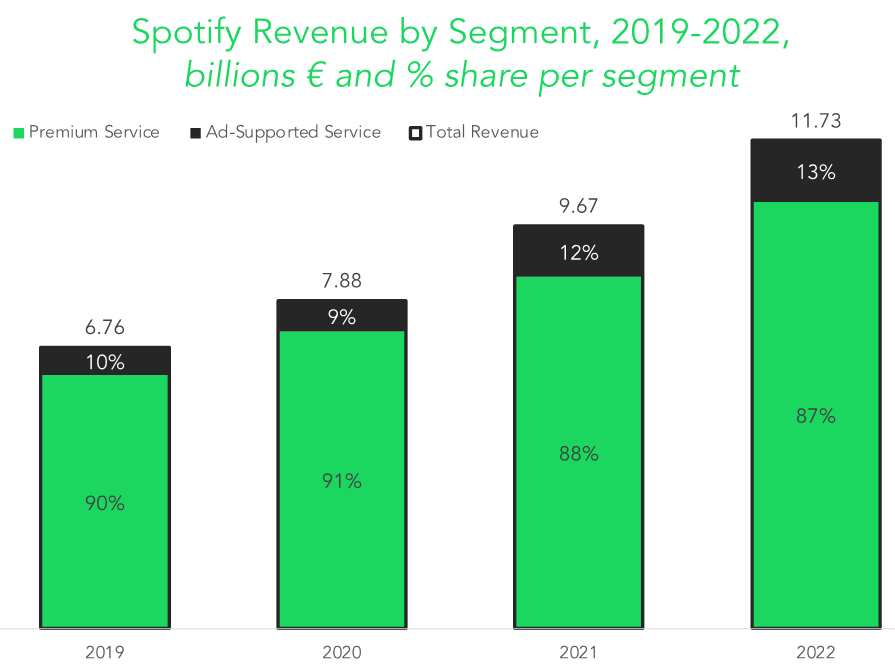
Spotify only has two reportable revenue streams, its Premium Service and Ad-Supported Service.
Its Premium Service generates monthly revenue from subscription fees that offer subscribers unlimited online and offline access to its catalog of music. The company’s Ad-Supported Service, on the other hand, generates revenue from the sale of display, audio and video advertising delivered through impressions across its content for non-paying users.
In 2022, its Premium Service segment generated €10.25 billion for an 87% share in revenue, while the Ad-Supported Service only accumulated €1.48 billion for the company. Both segments saw more than 20% increase compared to previous years’ figures.[16]
Although revenues across these two segments continue to grow year-over-year, the lack of other sources could be detrimental to Spotify in the long run. It makes the company vulnerable to unpredictable changes in its sources of revenue, such as a potential decrease in the number of paying subscribers or a decline in ad spending due to an economic downturn.
Furthermore, market saturation could also hurt these two streams, which may lead to a flat or even negative growth in overall revenue. This will limit the company’s ability to invest in new technology or services, and consequently, its competitiveness in the market. As such, Spotify must find new ways to monetize its user base while its primary revenue streams are growing to ensure continued growth.
2. Lack of competitive differentiation
Spotify competes in a market with limited differentiation in basic services provided to customers. While the company attempts to distinguish itself with unique features and experiences, it ultimately provides the same core service as its competitors — access to music and other audio content. As such, customers only typically consider two factors in choosing a streaming platform: the size of the library and the cost.
Given this limited differentiation, attracting and retaining customers is a daunting task for Spotify. It continues to invest heavily in providing enhanced listening experiences at the expense of its profitability. But if customers fail to see the value of these new features and functionalities, they can easily switch to other platforms.
Hence, Spotify must always ensure that its subscriptions tiers and size of library remain up to par with customers’ expectations. Else, it risks losing its market share to competitors.
3. Long history of unprofitability
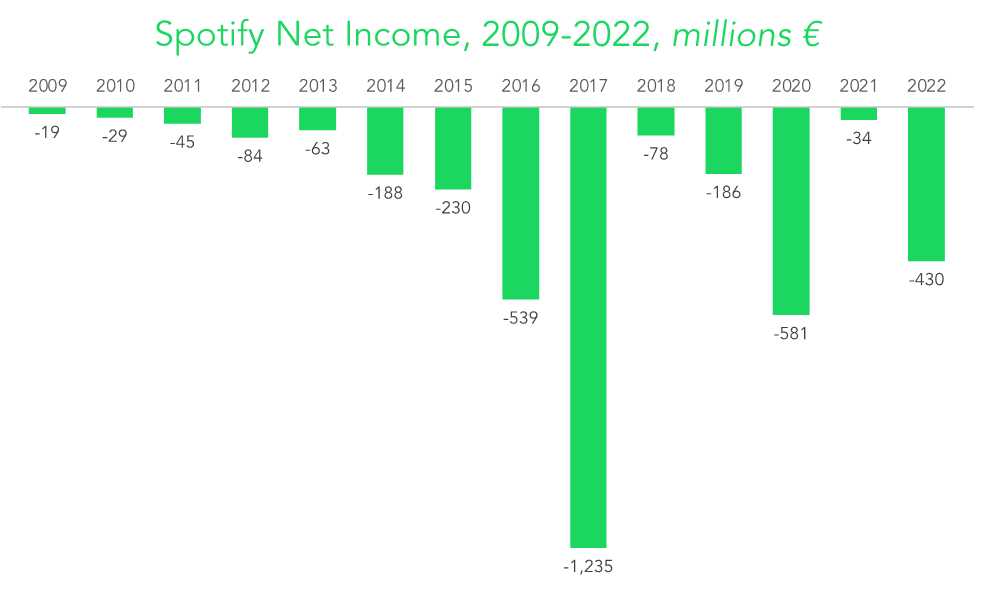
Despite being the market leader in the music streaming industry, Spotify has never made a profit. In 2022, it posted a net loss of €430 million, which was higher than the previous year’s loss of €34 million.[17]
The primary challenge that Spotify faces is rooted in its business model. A significant portion of the revenue generated from subscriptions and advertisements is spent annually on paying royalties. According to the company’s Loud and Clear website, almost 70% of its annual revenue is paid back to music rights holders, totaling nearly $40 billion since its inception.[18]
In addition, the intensifying competition in the streaming market compels Spotify to continue to heavily invest in research and development, as well as marketing activities. In 2022, the company spent a total of 25% on these two areas.
4. Royalty fees that are lower than competitors’

Although Spotify is allocating a significant portion of its revenue to royalties, it still receives criticism from artists and industry supporters. According to Headphonesty, the platform pays an average of $0.0033 in royalties per stream. This means that an artist would need over 300,000 streams to earn $1,000 on the platform. Most of Spotify’s competitors pay higher royalties to artists, which according to the same report range from $0.004 to $0.01 per stream.[19]
This issue has caused notable artists to criticize or leave the platform, such as Taylor Swift who removed her music in 2014 due to Spotify’s low artist payouts. In 2021, Paul McCartney, Kate Bush, and Sting joined a movement calling for then-U.K. Prime Minister Boris Johnson to enact reforms in the music streaming industry, including higher payouts.[20] GRAMMY Award-winner India Arie also voiced concerns and withdrew her music from Spotify, citing the company’s treatment of artists’ rights and low royalty fees.[21]
The low royalty fees can be traced back to the company’s pricing scheme. The platform calculates an artist’s streamshare to determine his or her allocation of the royalty pool generated from the Subscription and Ad revenue in each market.[22] Since Spotify implements localized pricing, streams in areas where subscription prices are relatively low would have lower royalty pools, resulting in lower average payouts to artists per stream.
Opportunities
1. Focusing on emerging markets
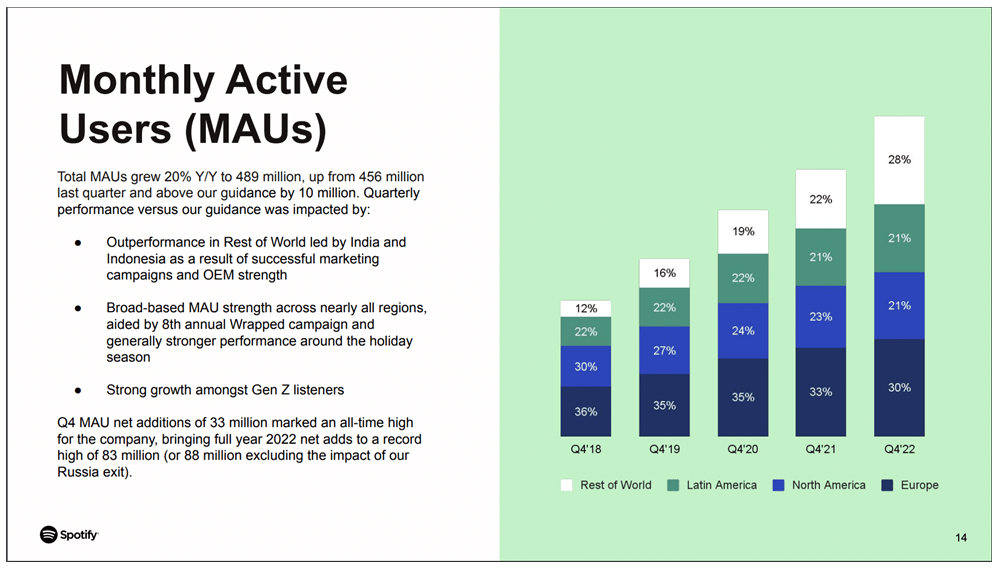
Spotify is now shifting its focus to emerging markets to continue its growth. According to the company, the total addressable market in emerging markets is around 2.7 billion, which is five times larger than the established market’s TAM of 600 million. And while Spotify has already captured 32% of the established market’s TAM, it has only acquired 8% of it in emerging markets.[23]
The company is already seeing significant growth in its user base in emerging markets, which rose from 12% of the company’s total monthly active users (MAUs) in 2018 to 28% in 2022. However, there is still an opportunity to convert more of these users into premium subscribers. As of end-2022, these markets have only contributed 12% to Spotify’s Premium Subscriber base.[24]
Therefore, doubling down on efforts to further increase its user base in these markets could be a key driver for Spotify’s future growth.
2. Expanding business segments
Spotify’s focus on research and development has allowed the company to provide better listening experiences and expand its offerings into new categories such as podcasts and audiobooks. However, the company still has room to grow to retain its existing user base, attract new customers, and diversify its revenue streams.
One potential area for expansion is live music streaming. Spotify already has the foundation for this with Spotify Live, but it could go further by enabling artists to stream live concerts directly to their fans through the platform. Spotify could charge a fee for access to the event, taking a percentage of ticket sales for hosting the concert digitally.
Another opportunity for growth is in music videos. Currently, users can only access bite-size videos that loop during playback. Expanding this feature to include full-length videos would allow users to stay within the Spotify platform instead of having to switch to another streaming service like Youtube to watch music videos.
3. Publishing original and/or exclusive content
As rights holders could publish their music across multiple streaming platforms, the ability to publish exclusive content could be a key differentiator for Spotify and its competitors in the future.
As such, Spotify could get a head start by potentially establishing a music studio where it can cultivate talent suitable for the international scene. The company could form various acts and work with them to create music that appeals to the current tastes of the company’s target audience using the insights it gets from customer data.
Alternatively, the company could also tap more established acts or artists, and encourage them to publish their content exclusively on its platform. One way to achieve this would be to offer more attractive deals, such as higher royalty fees or greater exposure of their content.
4. Venturing into new content verticals
Spotify has already started expanding its offerings beyond music, to include podcasts, and more recently, audiobooks. It should continue to explore more content verticals to drive growth.
For example, it can start bringing news programs into the platform. This would allow the company to expand its addressable market to include older generations who still consume news through traditional channels, like cable TV and broadcast radio.
In addition, Spotify could also explore introducing more sports content into the platform. While the company currently offers sports-related podcasts, it could also consider hosting live audio streaming of sports events. This could attract users who are always on the go and do not have immediate access to video-enabled devices but still want to follow their favorite teams and athletes.
Threats
1. Highly competitive music streaming market
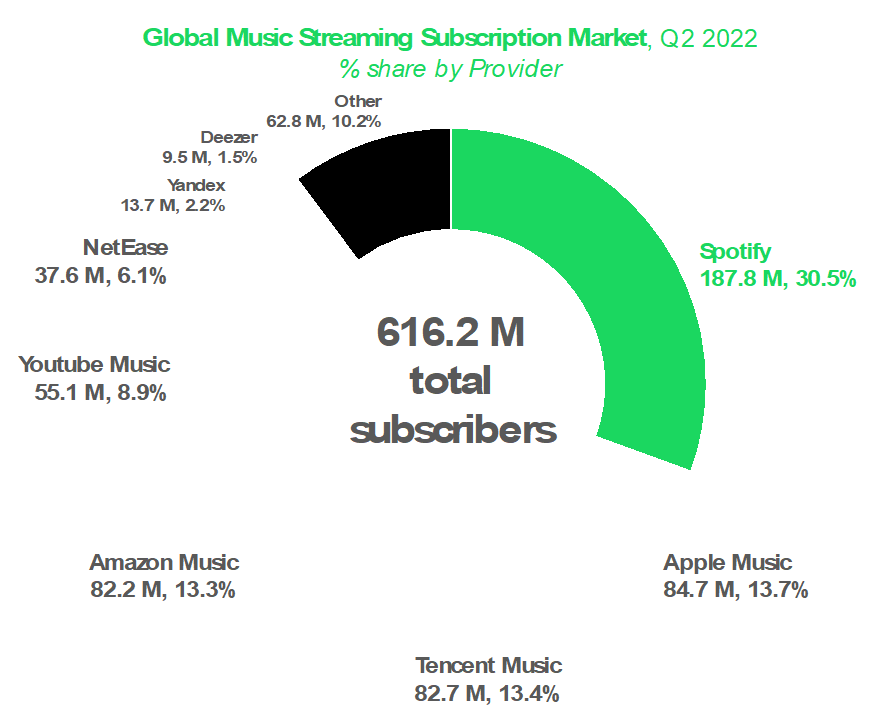
Source: Midia Research Ltd.
While Spotify currently holds a dominant position in the music streaming industry with almost one-third of the global market share, it is important for the company to remain vigilant of its competitors.[25]
Notably, some of the biggest players in the industry are tech giants like Apple, Amazon, and Google (via YouTube Music). All of them possess significant resources, longer histories, larger user bases, better brand recognition and more market knowledge that they can leverage to capture more market share.[26]
Furthermore, Spotify must also be aware of smaller, and non-mainstream players in the market who may be developing new and innovative value propositions that could attract customers away from the company. These smaller companies may not have the same level of resources as the tech giants, but their agility and ability to pivot quickly could prove to be a challenge for Spotify.
2. Emerging alternatives, particularly in the Web3 space
In addition to keeping an eye on its traditional competitors, Spotify must also stay vigilant for new alternatives that may arise in the music industry, especially in the Web3 space. This new frontier is already home to several crypto-based music streaming platforms that seek to disrupt the status quo of music streaming. Among these platforms are Audius, Choon, OPUS, BitSong, and Resonate.[27]
These platforms offer a unique approach to music streaming, using decentralized networks to connect artists directly to their fans without the need for a central entity like Spotify. This empowers artists to publish their content directly onto the network and start generating revenue instantly. And unlike traditional streaming platforms, these Web3 platforms do not take a percentage cut, which means that 100% of users’ payments and tips go directly to the artists.
If the adoption of Web3 continues to grow rapidly over the coming years, Spotify could be rendered obsolete by these emerging platforms. To stay relevant, the company must consider exploring the potential of Web3 and adapt to the changing landscape of the industry. This could involve developing new partnerships or integrating blockchain technology into its platform to stay ahead of the curve.
3. Consumers’ ever-shifting media consumption behavior
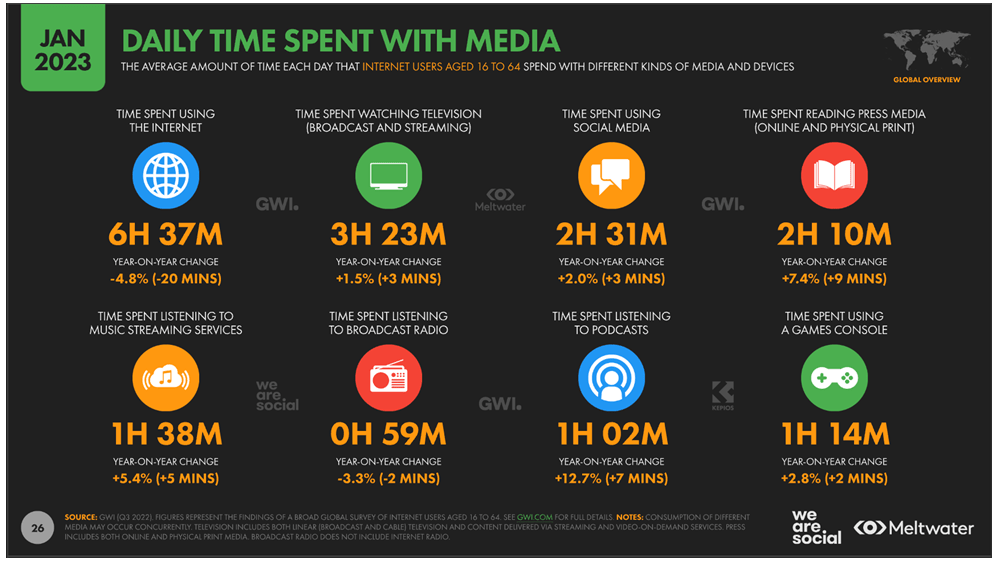
Source: Digital 2023: Global Overview Report
Spotify competes not only with other major players in the music streaming industry like Apple Music, Amazon Music, Tidal, and YouTube Music but also with a vast array of other media platforms that vie for customers’ ever-shortening attention spans. These include video streaming platforms such as Netflix, YouTube, and Twitch; social media platforms like Facebook, Twitter, TikTok, and Instagram; as well as gaming platforms and consoles like Steam, Nintendo Switch, Sony Playstation, and Microsoft Xbox.
According to the Digital 2023 Global Overview Report by We Are Social and Meltwater, users between the ages of 18 and 64 spend an average of one hour and 38 minutes per day listening to music on streaming services like Spotify and one hour and two minutes on podcasts.[28]
However, these pale in comparison to the amount of time spent watching broadcast or streaming television, which averages at three hours and 23 minutes, and using social media sites, which averages at two hours and 31 minutes.[29] The continued increase in consumption of these media platforms could lead to a decrease in the need for music streaming platforms, which could be detrimental to Spotify’s core business.
As a result, Spotify must continue its path to innovation to offer new experiences, services or content that could retain and even attract higher customer attention.
4. Vulnerability to persistent piracy
Despite being originally created to curb piracy, Spotify was only successful in achieving this goal in its early years. Towards the end of the 2010s, piracy began to ramp up again, with 73.9 billion visits to pirate sites globally in 2017, mostly via mobile phones.[30]
The proliferation of streaming platforms, not just for music, has led to a new model for the illegal reproduction of content called streamripping. In this practice, malicious actors use third-party mobile apps, software, sites or plugins to source and download content from licensed services to their local devices. In the U.K. alone, streamripping has experienced a sudden surge, growing more than ten-fold between 2016 and 2019, according to a 2020 report published by PRS for Music.[31]
Such prevalent actions to download and consume illegal copies of music content could adversely affect Spotify’s business. The increased accessibility of this technology may dissuade users from paying for access to streaming platforms. For artists, the rampant piracy by exploiting streaming platforms could result in a reluctance to upload their content to these platforms, in favor of more secure alternatives.
In order to preserve its market position and overall good reputation, the company must continue to explore how it can boost its security systems to deter malicious actions towards its library of content as well as its platform.
5. Changes in the regulatory environment
Spotify operates within a complex and heavily regulated industry where safeguarding customer data and intellectual property rights is of paramount importance. Any shifts in the regulatory environment related to these areas could significantly affect the company’s overall operations.
To ensure compliance with data privacy laws, Spotify must be vigilant, especially as laws vary in the markets it operates in. Non-compliance could result in multiple lawsuits, severe penalties, and, in extreme cases, the closure of operations. As lawmakers continue to explore how to better protect customers in this digital age, Spotify should remain aware of any changes in this regulatory area.
Regarding the protection of intellectual property rights, it is crucial for the company to secure all necessary rights from the rightful owners. Laws in this area are diverse, continually evolving, and subject to various interpretations. Therefore, Spotify must ensure it is fully compliant with these regulations before entering into license agreements with rights holders. Failure to do so could put the company in the middle of legal disputes between third-party entities that could damage its market reputation.
Summary
Spotify is the market leader in the music streaming industry with almost one-third of the total market share as of 2022.
To maintain its position, it must continue to leverage its extensive portfolio of internal capabilities and resources, as well as existing external relationships. The company should also find new ways to monetize its growing user base to finally achieve profitability, and potentially better reward music rights holders for contributing their content to the platform. Furthermore, it should continue its aggressive push to expand its content verticals and provide a wider range of offerings.
However, Spotify must do those things with high efficiency as competitors with vast amounts of resources are closing in. Moreover, new technologies are also being explored to transform the music industry once again, all to address the shifting needs and preferences of customers globally.
The company must also watch out for potential disruptions brought about by the external environment, including the increasing reliance on piracy to access audio content and the continuous evolution of the regulatory environment around consumer and data protection.
Sources
1. “15 Years of Spotify: How the streaming giant has changed and reinvented the music industry,” Variety, https://variety.com/2021/music/news/spotify-turns-15-how-the-streaming-giant-has-changed-and-reinvented-the-music-industry-1234948299/. Accessed April 12 2023.
2. “A nostalgic look back at digital music piracy in the 2000s,” The Next Web, https://thenextweb.com/news/a-nostalgic-look-back-at-digital-music-piracy-in-the-2000s. Accessed April 12 2023.
3. “U.S. Sales Database,” The Recording Industry Association of America, https://www.riaa.com/u-s-sales-database/. Accessed April 12 2023.
4. Ibid
5. “The Ledger: Are there really 100,000 new songs uploaded a day? Maybe more,” Billboard, https://www.billboard.com/pro/how-much-music-added-spotify-streaming-services-daily/. Accessed April 12 2023.
6. “Spotify 2022 Annual Report 20-F,” Spotify, https://s29.q4cdn.com/175625835/files/doc_financials/2022/q4/b283934e-7a7c-4da6-8749-856dfa4c36e6.pdf. Accessed April 12 2023.
7. “How Spotify uses ML to create the future of personalization,” Spotify R&D, https://engineering.atspotify.com/2021/12/how-spotify-uses-ml-to-create-the-future-of-personalization/. Accessed April 12 2023.
8. Spotify for Artists, https://artists.spotify.com/home. Accessed April 12 2023.
9. “Understand your audience better with the new release details page and audience engagement analytics, Spotify for Artists, https://artists.spotify.com/en/blog/release-details-page-and-audience-engagement-analytics. Accessed April 12 2023.
10. “Spotify debuts a new AI DJ, right in your pocket,” Spotify, https://newsroom.spotify.com/2023-02-22/spotify-debuts-a-new-ai-dj-right-in-your-pocket/. Accessed April 12 2023.
11. “Spotify premium price by country 2023,” How to Spotify, https://howtospotify.com/spotify-premium-price/. Accessed April 12 2023.
12. “Spotify and the streaming economy,” Loud and Clear, https://loudandclear.byspotify.com/#revenue. Accessed April 12 2023.
13. “Features,” Spotify for Artists, https://artists.spotify.com/features. Accessed April 12 2023.
14. “Provider Director,” Spotify for Artists, https://artists.spotify.com/en/providers. Accessed April 12 2023.
15. “Spotify 2022 Annual Report 20-F,” Spotify, https://s29.q4cdn.com/175625835/files/doc_financials/2022/q4/b283934e-7a7c-4da6-8749-856dfa4c36e6.pdf. Accessed April 12 2023.
16. Ibid
17. Ibid
18. Loud and Clear, https://loudandclear.byspotify.com/#revenue. Accessed April 13 2023.
19. “How much do Spotify & other music streaming platforms pay per stream?,” Headphonesty, https://www.headphonesty.com/2021/11/how-much-does-spotify-pay-per-stream/. Accessed April 13 2023.
20. “Spotify says it paid $7 billion in royalties in 2021 amid claims of low pay from artists,” Forbes, https://www.forbes.com/sites/marisadellatto/2022/03/24/spotify-says-it-paid-7-billion-in-royalties-in-2021-amid-claims-of-low-pay-from-artists/?sh=7897895fa0db. Accessed April 13 2023.
21. “India.Arie talks returning to spotify: ‘I deserve my checks’,” Billboard, https://www.billboard.com/music/rb-hip-hop/india-arie-spotify-interview-acoustic-soul-1235282673/. Accessed April 13 2023.
22. “Royalties,” Spotify for Artists, https://artists.spotify.com/en/help/article/royalties. Accessed April 13 2023.
23. “Spotify: Likely on track for a tenfold revenue expansion by 2030,” Seeking Alpha, https://seekingalpha.com/article/4563303-spotify-on-track-tenfold-revenue-expansion-2030. Accessed April 13 2023.
24. “Q3 2022 Shareholder Deck,” Spotify, https://s29.q4cdn.com/175625835/files/doc_financials/2022/q3/Q3-2022-Shareholder-Deck-FINAL-LOCKED.pdf. Accessed April 13 2023.
25. “Music subscriber market shares 2022,” Midia Research, Ltd., https://midiaresearch.com/blog/music-subscriber-market-shares-2022. Accessed April 13 2023.
26. “Spotify 2022 Annual Report 20-F,” Spotify, https://s29.q4cdn.com/175625835/files/doc_financials/2022/q4/b283934e-7a7c-4da6-8749-856dfa4c36e6.pdf. Accessed April 12 2023.
27. “Top 10 decentralized music streaming platforms to consider in 2022,” Dailycoin, https://dailycoin.com/top-10-decentralized-music-streaming-platforms-to-consider-in-2022/. Accessed April 12 2023.
28. “Digital 2023: Global Overview Report,” We Are Social and Meltwater, https://datareportal.com/reports/digital-2023-global-overview-report. Accessed April 13 2023.
29. Ibid
30. “Piracy is back: Piracy statistics for 2023,” DataProt, https://dataprot.net/statistics/piracy-statistics/. Accessed April 13 2023.
31. “Stream-ripping: Its role in the UK music piracy landscape three years on,” PRS for Music, https://www.prsformusic.com/-/media/files/prs-for-music/research/full-stream-ripping-research-report-2020.pdf. Accessed April 13 2023.

